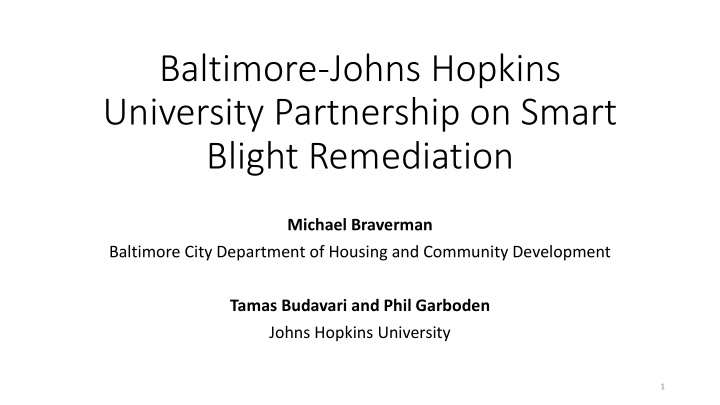



Baltimore-Johns Hopkins University Partnership on Smart Blight Remediation Michael Braverman Baltimore City Department of Housing and Community Development Tamas Budavari and Phil Garboden Johns Hopkins University 1
Presentation overview • Baltimore’s blight challenges • Making informed decisions • City/university partnership to meet data needs 2
Baltimore overview • Baltimore has lost 1/3 of its population since 1950 • Today, we have 16,500 boarded up vacant buildings • Of these, 13,000 are in distressed markets • Despite these conditions, we have developed capacity and made progress through strategic partnerships 3
Boarded up vacants 4
DHCD’s data infrastructure • DHCD maintains its own mapping system, CodeMap • We bring in information from our internal business systems that track vacant property notices and code enforcement interventions, and from the State Department of Assessments & Taxation, along with a host of other context data 5
DHCD uses different interventions to combat vacants, grow markets, and improve communities in different housing market typologies. Streamlined Code Enforcement Community Development Cluster Demolition Cluster 6
Example: Greenmount West VACANT BUILDINGS, OCTOBER 2008 (176) 7
CITY DISPOSITIONS (24 VACANT BUILDINGS; 55 VACANT LOTS) 8
RECEIVERSHIPS FILED (70) 9
DEMOLITIONS (21) 10
VACANTS REHABILITATED (140) OR UNDER PERMIT (13) 11
AFFORDABLE HOUSING REHABBED OR BUILT (MORE THAN 600 UNITS IN GREENMOUNT WEST AND BARCLAY) 12
NEW VACANT BUILDINGS (20) 13
VACANT BUILDINGS, NOVEMBER 2017 (40) 14
COMPARE TO: VACANT BUILDINGS, OCTOBER 2008 (176) 15
Middle market vacancy trends Vacant Buildings in Middle Markets 1/1 of Each Year 16
Unoccupied as indicator of neighborhood stability Many properties that were likely unoccupied 1.5 years ago have now become vacant. 17
Unoccupancy and demolition in a rowhouse environment 1800 block of Lauretta Based on an imperfect water data proxy, the two non-VBNs on the south side of this block are likely to be unoccupied. If so, demolition may be more affordable than it would otherwise appear. 18
1800 block of Lauretta (2011) 19
Identifying contiguous vacants in a rowhouse environment 2000 block of Harlem Among many vacants, it might not be obvious that 2019-23 could be demolished without building any walls, but for GIS analysis. 20
Using data to identify imminent dangers N. Calhoun & W. Lafayette Using data to identify end of group properties that may present an imminent danger, and demolishing those that present a safety risk. End of Group (EOG) Emergency Demolition 21
903 N. Calhoun 22
City+University Partnership Close collaboration for several years • Depts. of Applied Math & Stats and Sociology • Policy evaluation, rapid response, and research Projects • Vacant and Unoccupied properties • Demolition priorities and imminent danger • Understanding the impact of residency trends with qualitative data – Who is moving in? 23
City+University Partnership Close collaboration for several years • Depts. of Applied Math & Stats and Sociology • Policy evaluation, rapid response, and research Projects • Vacant and Unoccupied properties • Demolition priorities and imminent danger • Understanding the impact of residency trends with qualitative data – Who is moving in? 24
Who’s Moving In? Divestment and Investment in Baltimore’s Neighborhoods Poverty and Inequality Research Lab Johns Hopkins University Funded by the Annie E. Casey Foundation 25
Recommend
More recommend